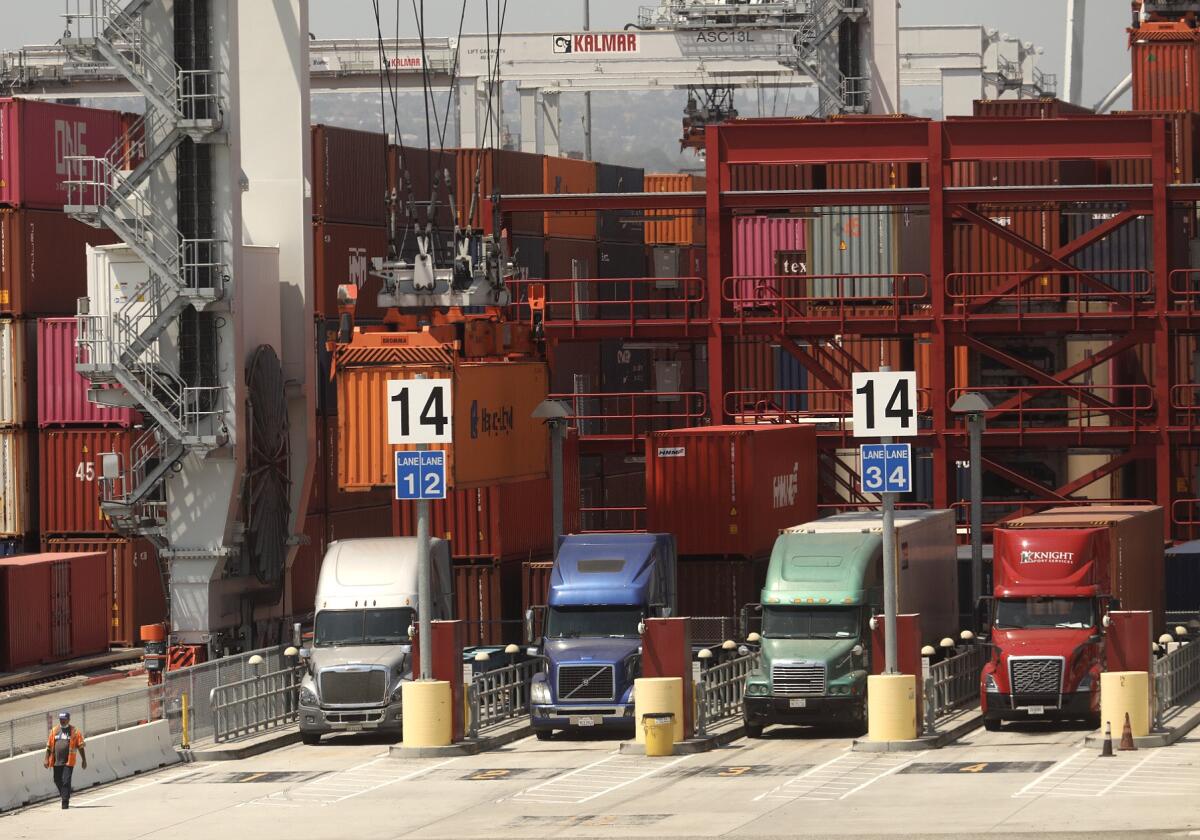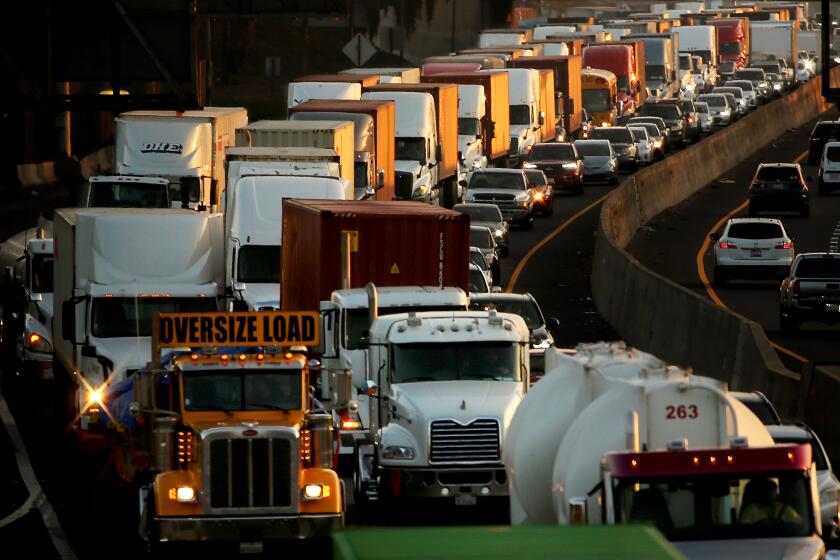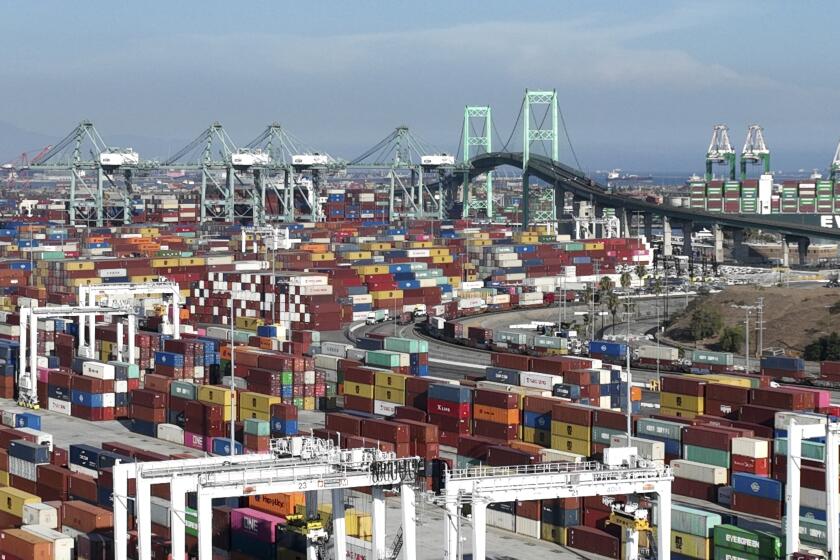If California’s regulations are so strict, why is our air still so bad?

- Share via
California just took another step to burnish its reputation as a leader in fighting pollution. Last month, the state’s air regulators set emissions rules for heavier vehicles and locomotives, including a requirement for all cargo trucks entering seaports and rail yards to be “zero-emission” by 2035.
This plan reflects the contradiction that has long characterized California’s air policy. The state seems at the forefront of pace-setting regulations — but it pursues those regulations because it has bad air. This year the American Lung Assn. reported L.A. to be the smoggiest metropolitan area in the nation, a title we’ve held all but one of the last 24 years. We can enact the new rules because the federal Clean Air Act made California the only state allowed to set its own motor vehicle emission standards, in recognition of our unique air quality challenges: abundant sunshine that produces more ozone and the geography of mountains and valleys that traps particles released from combustion, allowing them to build up.
California’s air has improved in recent decades. The San Joaquin Valley, known for having among the worst air in the nation, saw fewer days in violation of the federal ozone threshold in 2005 compared with 1995; 2015 was better still, with about half as many bad days as 1995. But starting from such a poor baseline means that even with improvements, in 2015 the valley still had 55 days of health-compromising ozone — slightly more than one day per week.
In a marathon two-day hearing, the California Air Resources Board voted on new regulations designed to limit pollution from locomotives and cargo trucks.
Now we’re also increasingly dealing with wildfire smoke: Eight of California’s 10 largest fires have been within the past decade, undermining recent progress and sending smog levels up again. Our more frequent, more intense fires increase pressure on California to get serious about combating deadly pollution.
The new regulations on trucks and trains answer part of this call. But we’ll need more expansive solutions to ensure that people’s health and mobility take precedence over goods movement in the quest for cleaner air.
Freight movement, including the trucks used to move most goods within and through the state, is responsible for about 50% of our air pollution. In line with broader patterns of environmental injustice, cargo movement concentrates pollution in specific neighborhoods. Coastal communities tend to be within or closer to pollution limits. The corridor connecting the ports of L.A. and Long Beach, downtown L.A. and the Inland Empire — now the dominant region for distribution warehouses — sees many more days of extreme violation of those limits, with some of the worst air in the nation. The Central Valley sees similarly dismal conditions.
To reduce these harmful emissions, there is a push to electrify everything, a transition that will be imposed on heavy vehicles and locomotives under California’s new standards. For some ground transportation, electrification adds a lot of benefit. It is ideal for lighter vehicles doing short-haul trips, which can charge between shifts. Last-mile delivery (such as USPS and Amazon) can be accomplished by electric trucks, delivery golf carts or even lighter cargo bikes.
Long distances and heavy cargo are harder. Eliminating the diesel and dirty shipping fuel they currently rely on is necessary to meet emissions targets. But heavy trucks require large batteries (while already carrying weighty cargo) and they lose more time recharging batteries on long trips. There are prototypes for vehicles powered by alternative fuels, including hydrogen-powered trucks, which would refuel quickly and more conveniently than electric vehicles. But hydrogen fuel is likely to be sourced from fossil gas.
Besides, even if it were practical for all vehicles, electrification is no panacea. About 40% of California’s electricity comes from burning fossil fuel, meaning electric vehicles are “zero-emission” only at tailpipes, not overall. (And tires, not only combustion, also release significant toxic particulates near roadways.)
The pandemic supply chain crisis and our recovery create a rare opportunity to plan for a livable future.
All of this indicates that swapping in new fuel sources alone won’t be enough to get emissions to healthful levels. We need to reexamine system-level choices and put novel solutions on the table. Instead of just thinking about how to make new technology replicate exactly the transportation systems we have, California should rethink its economic dependence on moving freight at the current volume, distance and speed, which come at the expense of human health.
This mentality can be instructive for other state-mandated environmental changes. For example, beginning in 2024, California has banned sales of new gas-powered lawnmowers and leaf blowers (running a commercial leaf blower for one hour emits pollution comparable to that of driving a new passenger car about 1,100 miles). But existing machines are allowed to operate for as long as they can be maintained, meaning it could take another decade before related emissions drop significantly. Why not incentivize raking rather than leaf blowing, alongside planting drought-resistant trees and native plants that demand less water, absorb carbon and particulates and are more resilient to worsening climate stress than high-maintenance lawns?
Instead of just pushing people to transition to electric cars — while permitting egregiously polluting private jets — why don’t we retool infrastructure to encourage walking, biking and public transportation? These are more democratic and less deadly forms of mobility, using less fossil fuel and less electricity. Even people with cars will benefit from having better alternatives to driving. Reduced reliance on petroleum will also make it easier to carry out California’s setback law banning oil extraction near homes, schools, playgrounds and parks, which is embattled despite being popular with state residents.
Given California’s challenges, officials may be tempted to continually grant “state of exception” permits, which allow industries to exceed pollution thresholds. But we are in a new normal, not a state of exception. Californians, our regulators and our elected officials have to not only stick with ambitious rules to replace fossil fuels, but also envision ways for us to use less energy, period.
Christina Dunbar-Hester is a communication professor at the Annenberg School for Communication and Journalism at USC, a current member of the Institute for Advanced Study and the author of “Oil Beach.”
More to Read
A cure for the common opinion
Get thought-provoking perspectives with our weekly newsletter.
You may occasionally receive promotional content from the Los Angeles Times.











